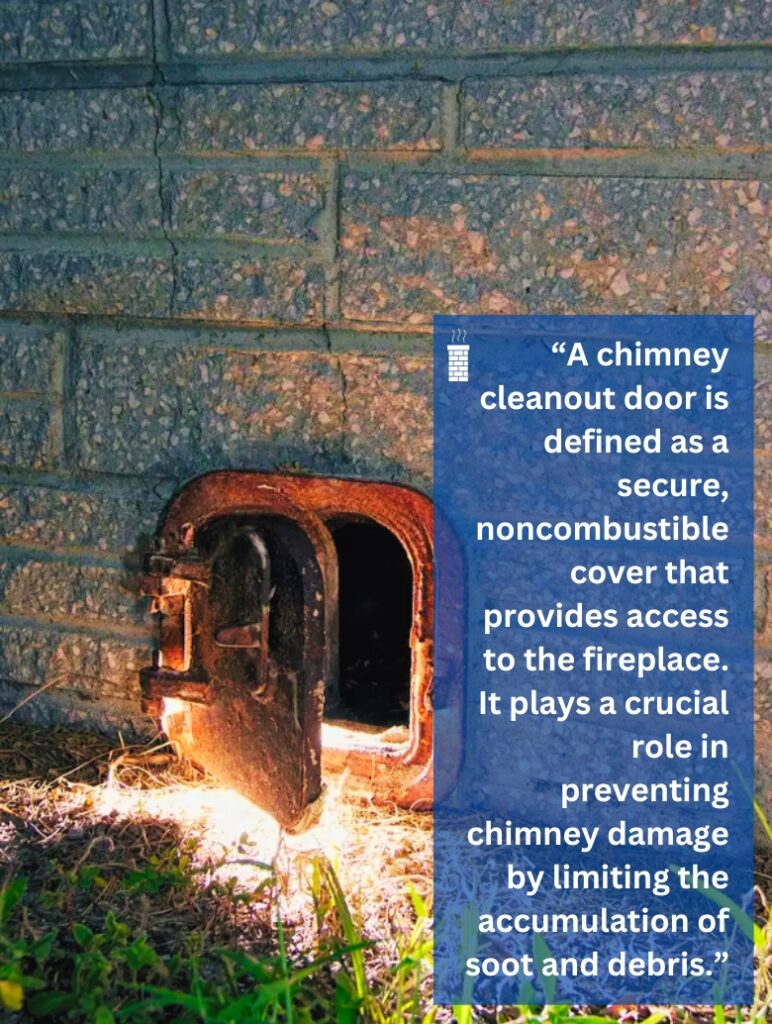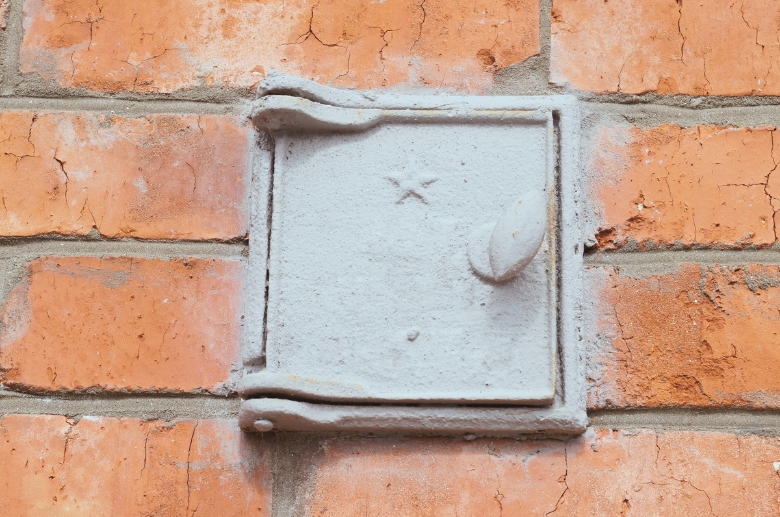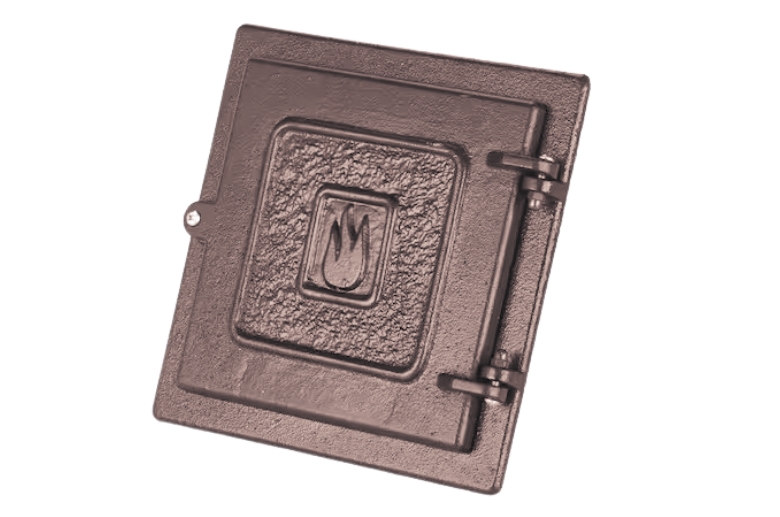When pondering over the often-overlooked aspects of home maintenance, the question “Do I Need a Chimney Cleanout Door?” might not top your list. However, it’s an important aspect to consider.

A chimney cleanout door is defined as a secure, noncombustible cover that provides access to the fireplace. It plays a crucial role in preventing chimney damage by limiting the accumulation of soot and debris.
In this article, we will dive into the importance of a chimney cleanout door, covering its definition, benefits, maintenance, and safety considerations.
Let’s get started.
——
Do You Need to Hire Chimney & Fireplace Expert?
Get free quotes from qualified experts near you. No commitment required!
——
What Is The Purpose of a Chimney Cleanout Door?
In essence, a chimney cleanout door is a small opening or access point in a chimney that allows for the removal of debris. It emphasizes the importance of chimney cleaning, especially when considering the risks of uncleaned chimneys.
Ignoring regular cleaning could lead to significant hazards, such as dangerous blockages or the potential for chimney fires. Thus, the cleanout door is not just a functional feature; it’s a key element in safeguarding your home against these risks.
making chimney maintenance easier.
Chimney cleanout doors are typically made of durable materials, such as metal or masonry, to ensure the longevity of your chimney. From hinged doors to removable panels, the market offers choices to suit different chimney structures. Understanding these types ensures you pick the one that seamlessly integrates with your chimney’s design while offering easy access.
Why Do I Need a Chimney Cleanout Door?

A cleanout door makes chimney maintenance easier, allowing for swift and efficient sweeping and inspections. This simple addition can save you time, effort, and potentially costly repairs.
Cleaning a chimney without a cleanout door is like trying to fix a car without lifting the hood – challenging and inefficient. With a cleanout door, chimney professionals can access the heart of your chimney with ease.
Limited access might mean issues within your chimney go unnoticed. Problems like blockages, creosote buildup, or structural damage may remain hidden until they become serious and costly.
Even if you don’t use your fireplace often, chimney cleaning is still needed. Therefore, having a cleanout door makes chimney cleaning and maintenance simpler.
How to Install a Chimney Cleanout Door

When preparing to install your chimney cleanout door, here are the steps you should take.
Before you start installing, think about key factors. Pick a cleanout door that fits your chimney’s specs, considering size, dimensions, and durable materials. Choose a door that can handle weather elements for long-term performance.
Gather your tools beforehand. Typically, you’ll need a power drill, screwdriver, measuring tape, and the cleanout door kit with all necessary components. Having everything ready streamlines the installation process.
Installation Steps
A properly installed cleanout door promotes better air circulation in the chimney, enhancing combustion efficiency. Here’s what you need to do when installing a chimney cleanout door.
Step 1. Locate the Installation Site: Identify the ideal spot for your cleanout door, ensuring easy access for maintenance.
Step 2. Mark and Measure: Accurately measure the dimensions, marking where the door will be installed.
Step 3. Prepare the Opening: Use your power drill to create an opening for the cleanout door.
Step 4. Attach the Door Frame: Secure the door frame in place using the provided screws.
Step 5. Install the Door: Affix the cleanout door onto the frame, ensuring a snug fit.
Step 6. Test for Smooth Operation: Check that the door opens and closes smoothly.
Common Challenges and Solutions
Installing a cleanout door may come with challenges.
- Uneven Surfaces: If your chimney has uneven surfaces, use shims to create a level foundation for the door.
- Tight Spaces: Consider buying a smaller, more compact cleanout door for easier installation in confined spaces.
When installing a chimney cleanout door, the choice between professional installation and a DIY approach hinges on several factors. Let’s explore when to call in an expert and the risks and benefits of taking the DIY route.
When to Call a Professional

If you’re unsure of how to install a chimney cleanout door, a professional may be able to help. Here are some scenarios for when you should call a professional.
- Limited Expertise: If you lack experience handling tools or have minimal knowledge and information about chimney structures, seek professional assistance.
- Structural Complexity: For chimneys with complex or non-standard designs, a professional’s expertise is crucial.
- Time Constraints: A professional can ensure quick and efficient installation, which is ideal when time is a limiting factor.
- Compliance with Regulations: Professionals are well-versed in local building codes and safety regulations, ensuring your installation meets all necessary standards.
Pros and Cons of DIY Installation
When considering the installation of a chimney cleanout door within a budget, it’s essential to weigh the advantages and potential drawbacks of a DIY approach. Here’s an overview for your consideration.
Pros
- Cost Savings: DIY installation can save you money on labor costs.
- Personal Satisfaction: Completing a DIY project brings a sense of accomplishment and ownership.
- Flexible Schedule: You can work independently, adjusting the installation timeline to suit your availability.
Cons
- Incomplete Understanding: Lack of comprehensive knowledge may result in incomplete or incorrect installation.
- Safety Concerns: Handling tools and climbing ladders can pose safety risks for individuals without proper experience.
- Potential Damage: Incorrect installation may lead to structural damage, reducing the chimney’s effectiveness.
When making this decision, carefully assess your skill level, the complexity of the installation, and your available time. While a DIY approach can be fulfilling, professional installation ensures precision and compliance with regulations, providing peace of mind for homeowners.
——
Do You Need to Hire Chimney & Fireplace Expert?
Get free quotes from qualified experts near you. No commitment required!
——
What Are the Requirements for a Chimney Cleanout Door?
The NFPA establishes standards to enhance fire safety. For chimney cleanout doors, these standards encompass materials, design, and installation practices. Local building codes and regulations may require homeowners to install a cleanout door in their chimneys for safety reasons.
Size and Location Requirements
For size and location requirements, here’s what you need to know.
- Size Considerations: The cleanout door should be proportionate to the chimney’s size, allowing for easy access during maintenance.
- Optimal Location: Placement should be near the chimney’s base, ideally at ground level, for ease of access while maintaining structural integrity.
Clearance Requirements
Clearance requirements have specific conditions, such as:
- Structural Clearance: This involves a safe distance between the cleanout door and combustible materials. For instance, the door should be within 6 inches of the chimney base and at least 6 inches below any chimney inlet, with a minimum height of 6 inches for the opening.
- Accessibility Clearance: Ensuring adequate space around the cleanout door allows convenient access during cleaning and inspections. Additionally, a noncombustible cover must be provided for the cleanout.
Meeting these clearances is essential for safety compliance and efficient chimney maintenance.
Chimney Cleanout Door Replacement Cost
When replacing your chimney cleanout door, the costs involve the purchase of the cleanout door, installation, and ongoing maintenance.
The cost of the cleanout door itself varies based on factors like material, size, and design. On average, prices can range from $100 to $700.
Different materials may have different price ranges, with stainless steel typically being more expensive than galvanized steel. For instance, stainless steel cleanout doors are priced from $70 to $200, whereas galvanized steel cleanout doors are priced from $30 to $50.
In case you decide to hire a professional, installation costs may vary, ranging from $100 to $300, depending on your location and the complexity of the installation.
Here’s a simplified table outlining the estimated costs based on chimney size:
| Chimney Size | Cleanout Door Cost | Installation Cost |
| Small (1 flue) | $50 – $100 | $100 – $200 |
| Medium (2-3 flues) | $100 – $150 | $150 – $250 |
| Large (4+ flues) | $150 – $200 | $200 – $300 |
Remember, these are rough estimates, and actual costs may vary. Obtaining quotes from local professionals for accurate pricing tailored to your specific circumstances is advisable.
Final Words
A Chimney cleanout door is a crucial component for maintaining a healthy and efficient chimney. Its easy access facilitates cleaning and inspections, ensuring proper chimney function and preventing potential hazards.
This simple addition aids in debris removal, averting risks that might otherwise go unnoticed. While some may attempt it as a DIY project, seeking professional assistance guarantees precision, ensuring optimal fireplace and heating system operation.
Reach out to professionals for a consultation to assess your needs and guide you in selecting the ideal cleanout door.






